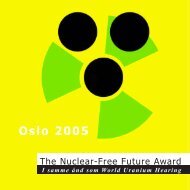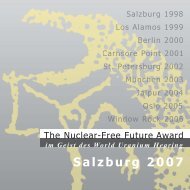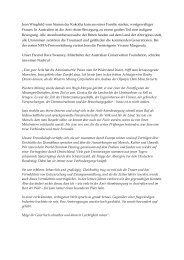New York City - The Nuclear-Free Future Award
New York City - The Nuclear-Free Future Award
New York City - The Nuclear-Free Future Award
Create successful ePaper yourself
Turn your PDF publications into a flip-book with our unique Google optimized e-Paper software.
I. Man-hatta, the hilly island, was used by the Algonquinspeaking<br />
Leni Lenape as a summer fishing outpost. Another<br />
tradition tells of a people living there who called themselves the<br />
Manhattan. Whatever is true, when the annual mosquito plague<br />
was at its worst, here at the mouth of the river the whites would<br />
come to call the Hudson, there was wind enough to keep the nasty<br />
little demons at bay. <strong>The</strong> Dutch felt comfortable in the surroundings,<br />
and exchanged some sixty guilders worth of trinkets to<br />
purchase the land and<br />
settle. <strong>The</strong> Native<br />
Amer-icans accepted<br />
the barter without<br />
really understanding the concept of real estate possession; to<br />
fish and trade with the whites they continued to return and set<br />
up their encampments. Manhattan’s new owners built ramparts at<br />
the northernmost end of the set-tlement, de Waal. We know with<br />
certainty where the barrier stood: Wall Street marks the location.<br />
Outside de Waal the Indians could barter their furs, and still today<br />
Wall Street is a place of commerce. Here uranium amounts to<br />
just another commodity.<br />
Foreword<br />
II. Once President Franklin D. Roosevelt, at the urging of Albert<br />
Einstein, made the development of the atomic bomb part of the<br />
country’s military agenda, scientists, engineers, and men in uniform<br />
rendesvoued in <strong>New</strong> <strong>York</strong>, <strong>New</strong> <strong>York</strong>. <strong>The</strong> code name for<br />
the undertaking lay not far from hand: the Manhattan Project.<br />
Two addresses were important meeting places for the initiates of<br />
the A-bomb program: the Bell Laboratories Building (463 West<br />
Street), and the Woolworth Building (233 Broadway). <strong>The</strong> secret<br />
project quickly became a mammoth undertaking, branching out<br />
across the continent from Tennessee to <strong>New</strong> Mexico to way on<br />
up in Ontario. <strong>The</strong> headquarters were hidden in the mountains of<br />
northern <strong>New</strong> Mexico: Los Alamos, the birthplace of the Atomic<br />
Age. Here the bombs dropped on Hiroshima and Nagasaki were<br />
engineered, constructed.<br />
III. Traditional Native Americans concieve of time as being circular.<br />
In 1870 at the newly built academy called Cooper Union,<br />
Chief Red Cloud of the Oglala Lakota gave a speech outlining his<br />
concerns about the future of his people. In the Great Hall some<br />
4<br />
On Manhattan and the Manhattan Project.<br />
And on the closing of circles.<br />
ten years prior, Abraham Lincoln delivered his famous “Right<br />
Makes Might” address. On September 30th Henry Red Cloud<br />
will give a speech from behind the red velvet of the same lectern,<br />
talking about his work on the Pine Ridge Reservation. <strong>The</strong>re he<br />
trains young Lakota to become solar engineers. His hope is that<br />
renewable energies will save the He Sapa (Black Hills) from a<br />
new wave of uranium mining. Henry is a great-great-great grandson<br />
of Chief Red Cloud.<br />
IV. For our group a circle completes<br />
at the old Bell Laboratories Building,<br />
which today is called Westbeth, and<br />
offers live/work spaces to artists of<br />
many disciplines. In May of 1990 at<br />
the Ramscale Loft on the 13th floor,<br />
we first went public with our plans<br />
for the World Uranium Hearing; two<br />
years later, the WUH gathering took<br />
place in Salzburg, Austria. In 1998<br />
we returned to Ramscale and announced<br />
our follow-up project: <strong>The</strong><br />
<strong>Nuclear</strong>-<strong>Free</strong> <strong>Future</strong> <strong>Award</strong>. Again<br />
this year we will gather at the old Bell<br />
Laboratories site, laureates, organizers,<br />
and many supporters. In 1999<br />
the second annual <strong>Award</strong>s ceremony<br />
was held in Los Alamos at Fuller<br />
Lodge, the Manhattan Project’s canteen<br />
and Sunday dance hall. To help<br />
undo the grips of the tragic past, it is important to revisit the sites<br />
of its shaping with new drive, new energies, new values.<br />
Claus Biegert<br />
V. We have a clear goal: we demand a future free of nuclear<br />
weapons and nuclear power. Uranium is not simply another commodity.<br />
Our civilization is mired in a dilemma: we take what<br />
we need to preserve our lifestyle, while at the same time we<br />
deplete the earth of life’s essentials. “Whatever we do today, we<br />
must always consider the well-being of the seventh generation<br />
to come” – the Great Law of the Haudenosaunee, whom we call<br />
the Iroquois – can help us from our predicament.





